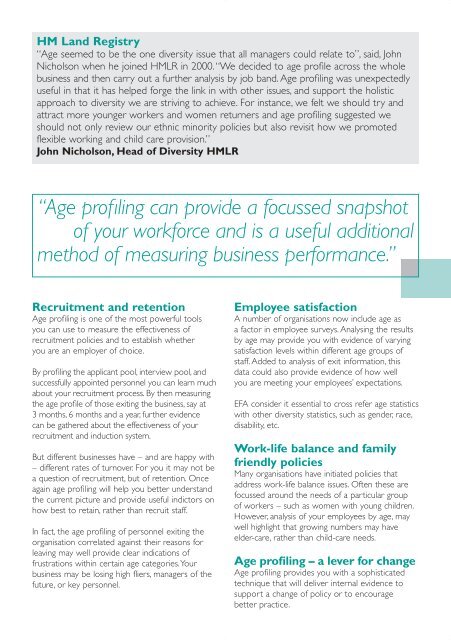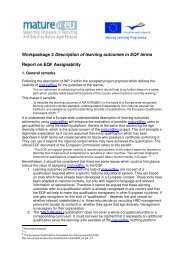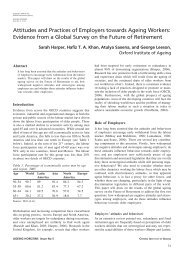Age profiling - Mature @ EU
Age profiling - Mature @ EU
Age profiling - Mature @ EU
- No tags were found...
You also want an ePaper? Increase the reach of your titles
YUMPU automatically turns print PDFs into web optimized ePapers that Google loves.
HM Land Registry<br />
“<strong>Age</strong> seemed to be the one diversity issue that all managers could relate to”, said, John<br />
Nicholson when he joined HMLR in 2000. “We decided to age profile across the whole<br />
business and then carry out a further analysis by job band. <strong>Age</strong> <strong>profiling</strong> was unexpectedly<br />
useful in that it has helped forge the link in with other issues, and support the holistic<br />
approach to diversity we are striving to achieve. For instance, we felt we should try and<br />
attract more younger workers and women returners and age <strong>profiling</strong> suggested we<br />
should not only review our ethnic minority policies but also revisit how we promoted<br />
flexible working and child care provision.”<br />
John Nicholson, Head of Diversity HMLR<br />
“<strong>Age</strong> <strong>profiling</strong> can provide a focussed snapshot<br />
of your workforce and is a useful additional<br />
method of measuring business performance.”<br />
Recruitment and retention<br />
<strong>Age</strong> <strong>profiling</strong> is one of the most powerful tools<br />
you can use to measure the effectiveness of<br />
recruitment policies and to establish whether<br />
you are an employer of choice.<br />
By <strong>profiling</strong> the applicant pool, interview pool, and<br />
successfully appointed personnel you can learn much<br />
about your recruitment process. By then measuring<br />
the age profile of those exiting the business, say at<br />
3 months, 6 months and a year, further evidence<br />
can be gathered about the effectiveness of your<br />
recruitment and induction system.<br />
But different businesses have – and are happy with<br />
– different rates of turnover. For you it may not be<br />
a question of recruitment, but of retention. Once<br />
again age <strong>profiling</strong> will help you better understand<br />
the current picture and provide useful indictors on<br />
how best to retain, rather than recruit staff.<br />
In fact, the age <strong>profiling</strong> of personnel exiting the<br />
organisation correlated against their reasons for<br />
leaving may well provide clear indications of<br />
frustrations within certain age categories.Your<br />
business may be losing high fliers, managers of the<br />
future, or key personnel.<br />
Employee satisfaction<br />
A number of organisations now include age as<br />
a factor in employee surveys. Analysing the results<br />
by age may provide you with evidence of varying<br />
satisfaction levels within different age groups of<br />
staff. Added to analysis of exit information, this<br />
data could also provide evidence of how well<br />
you are meeting your employees’ expectations.<br />
EFA consider it essential to cross refer age statistics<br />
with other diversity statistics, such as gender, race,<br />
disability, etc.<br />
Work-life balance and family<br />
friendly policies<br />
Many organisations have initiated policies that<br />
address work-life balance issues. Often these are<br />
focussed around the needs of a particular group<br />
of workers – such as women with young children.<br />
However, analysis of your employees by age, may<br />
well highlight that growing numbers may have<br />
elder-care, rather than child-care needs.<br />
<strong>Age</strong> <strong>profiling</strong> – a lever for change<br />
<strong>Age</strong> <strong>profiling</strong> provides you with a sophisticated<br />
technique that will deliver internal evidence to<br />
support a change of policy or to encourage<br />
better practice.
















